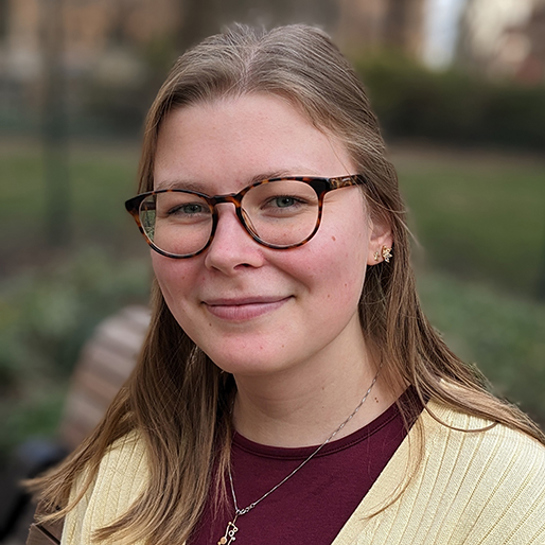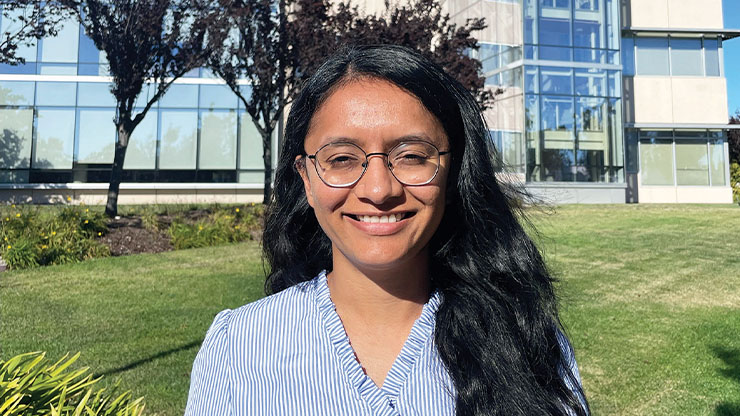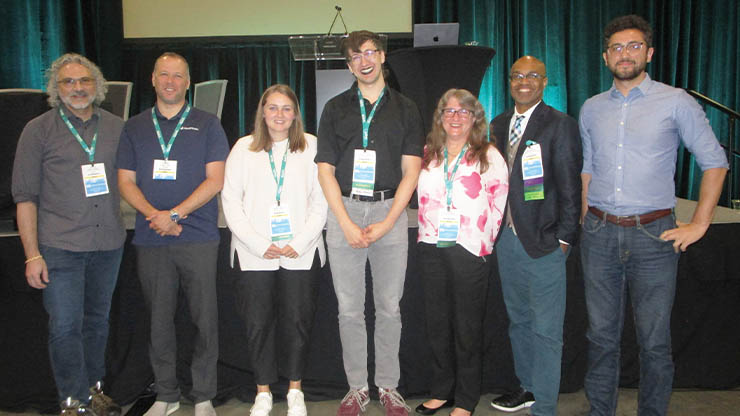Industry Panel at AN24 Considers Career Opportunities Outside of Academia
Researchers in industry and the national laboratories routinely utilize a wide variety of mathematical tools, leading to a high demand for applied mathematicians and computational scientists in these spaces. During the 2024 SIAM Annual Meeting—which took place in Spokane, Wash., this past July—Sharon Arroyo of The Boeing Company moderated an industry career panel that explored the realities of non-academic positions and outlined the various routes to these roles. Panelists Amanda Howard of Pacific Northwest National Laboratory; Nicole Jackson of Sandia National Laboratories; John-Paul Sabino of The Boeing Company; Gwen Spencer of Netflix; and Wotao Yin of Alibaba Group/Academy for Discovery, Adventure, Momentum and Outlook shared their insights with an engaged audience.
Spencer explained that she was initially drawn to industry for the chance to work on applied topics with interesting collaborators. “There was really an aspect of wanting to test my training,” she said. “I wanted to have access to people who know completely different things, and I heard from lots of people that industry was the place to do this.” Yin likewise acknowledged the diversity of projects in industry, noting that he appreciates the progression from finding a core initial idea to delving into the related literature and ultimately outputting a finished product that customers will pay to use. Similarly, Sabino enjoys the gratification of watching what he visualizes come to life through coding and development. “To me, that’s one of the best aspects of what I’m able to do — to scratch that creative itch,” he said. “It’s as close to real-life magic as we get. This is a highly creative profession, which the vast majority of people outside of our field don’t appreciate.”

Jackson, who works within the national laboratory ecosystem, values the opportunities to collaborate with colleagues in academia. “I get to oscillate quite nicely from doing fundamental research to bringing it back to the really applied setting,” she said. As such, scientists in national labs often divide their attention between several different pursuits at once. “You can find a portfolio of projects that are interesting to you and that build skills for each other,” Howard said.
When conversation turned to daily life at a national lab, Howard explained that her workplace is still highly virtual and she often works from home when programming, writing grants and papers, or meeting with collaborators. As a senior machine learning scientist at Netflix, Spencer purposely plans her schedule to accommodate multiple work streams. “I spend at least 60 to 70 percent of my day doing technical work, and some amount of time developing slide decks and going to meetings,” she said. The panelists collectively utilize a multitude of mathematical techniques in their roles, including geometric data structures, partial differential equation-constrained optimization, physics-informed machine learning, linear programming, and generative adversarial networks.
All jobs almost always involve both stimulating tasks and some inevitably frustrating aspects. One potential source of strain is that industry researchers cannot disclose, publish, or discuss trade secrets, which means that some important accomplishments cannot be shared. And like other professionals, industry employees must also deal with monetary uncertainty at times. “You usually have more ideas about what you want to do than reliable and predictable income streams to fund them,” Sabino said.
Jackson’s favorite parts of her position at Sandia National Laboratories include the “a-ha” moment when uncertainty turns into an exciting result, and the process of receiving feedback from industry partners. In contrast, one of the most vexing aspects is funding rejection. “One of the things that I’ve learned over the years is that rejection is going to happen, and you have to figure out how to move on,” she said. Because each funding opportunity receives a huge number of proposals, Howard tries to not take rejection too personally. And fortunately, applied mathematics is relevant to a wide variety of research pursuits. “I don’t ever have a shortage of projects because I can fit into a lot of different ones,” Howard said. While working within these types of cross-cutting collaborations, mathematicians can learn more about the priorities of different funding offices and grow their connections with individuals in an assortment of roles. “A lot of it comes down to forming a network of people within your organization,” Jackson said.
Explaining mathematical concepts in general terms is an essential skill in both industry and the national laboratories. “In terms of communicating mathematics to a less technical audience, we rely on the tried-and-true analogy,” Sabino said. Knowing the audience is key — are they technical experts in a different field or managers who probably do not want to see a lot of equations? “I like to think of it as ‘what is the story I’m going to tell?’ and hopefully bring people along on that journey,” Jackson said. “What are the takeaways that the people listening are hopefully going to walk away with? How can I communicate this in a highly visual way?”
Mathematicians in application-focused workplaces must also occasionally make peace with inelegant solutions. “There are all kinds of businesses,” Yin said. “Some businesses do not worry as much about accuracy.” For instance, financial institutions usually recognize the challenges that accompany their very noisy data. Spencer stated that she enjoys the simplicity that comes from conquering a problem with just one or two features — perhaps via an approach that provides 80 percent of the value with 20 percent of the effort. “You develop different ways of thinking about how you triumphed over a problem,” she said. Howard similarly reframes her processes when necessary. “I think an effective approximation is often the elegant and harder solution,” she said.
As discussion turned to career path options, the panelists urged students to explore many different possibilities through projects, coursework, or internships. “What makes you excited to do the technical work that you’re interested in?” Jackson said. “If you have a large problem space, what part of that space are you intrinsically motivated by? I encourage you to think about what makes you excited, and what could make you want to get up to do the work.”

Additionally, it is important to consider whether the market for a certain type of role is emerging, stable, or growing, and whether companies will likely continue to value that role; all of these factors will determine the number of available opportunities in the future. Concentrating on a very niche field could cause trouble if the associated skillset becomes less relevant over time. “If you master two different techniques, you have a much better chance,” Yin said, adding that one should also contemplate the long-term growth potential of multiple career pathways. “Let’s say that you do algorithms. You can choose between places where an algorithm makes decisions, or where an algorithm supports human decision-makers.”
LinkedIn is a good platform on which to maintain personal networks while establishing new connections across different organizations. “If you know people who like the companies they work at, it can help to ask to be referred,” Spencer said. “Lots of companies offer referral bonuses.” Furthermore, meeting employees at conferences and during job interviews is a great way to get to know an organization. “I think that there’s a lot of heterogeneity in how companies understand the role of science in their potential,” Spencer added.
When applying for jobs after graduating with a Ph.D., an applicant’s thesis does not need to directly relate to the job description in question. In fact, Sabino recalled one interviewer who told him not to be disappointed if he never worked on his thesis topic again. “Mathematicians are highly versatile,” he said. “They can solve a variety of problems, as this panel has demonstrated. There’s relatively few applied mathematicians, and they can work in a wide variety of areas.” But if early-career scientists are hoping to make a major transition after graduate school, some interstitial experience may nonetheless be helpful. “Postdocs are a really good option if you’re looking to transition away from your thesis topic,” Howard said. “Pick something that bridges the two.”
For individuals with Ph.D.s in pure mathematics who are interested in the applied world, additional experiences—like internships at national laboratories that span pure and applied math—are particularly essential. “If you can add a sentence [in your resume] on the area of research, those key words are really important,” Yin said. Hard skills like programming and soft skills like collaboration are likewise crucial in many job application processes. “A big question mark we have for any candidate is whether they are going to be able to transition well into working with teams,” Sabino said.
As their final advice, the panelists reemphasized the value of exploring different domains as a student, developing a toolbelt with a range of mathematical techniques, and maintaining a strong network. “If you want something, don’t be afraid to let people know,” Sabino said. “Making connections with people—just talking with people—can help build those little networks that lead to a job.”
About the Author
Jillian Kunze
Master's student, Drexel University
Jillian Kunze is the former associate editor of SIAM News. She is currently a master’s student in data science at Drexel University.

Related Reading
Stay Up-to-Date with Email Alerts
Sign up for our monthly newsletter and emails about other topics of your choosing.






